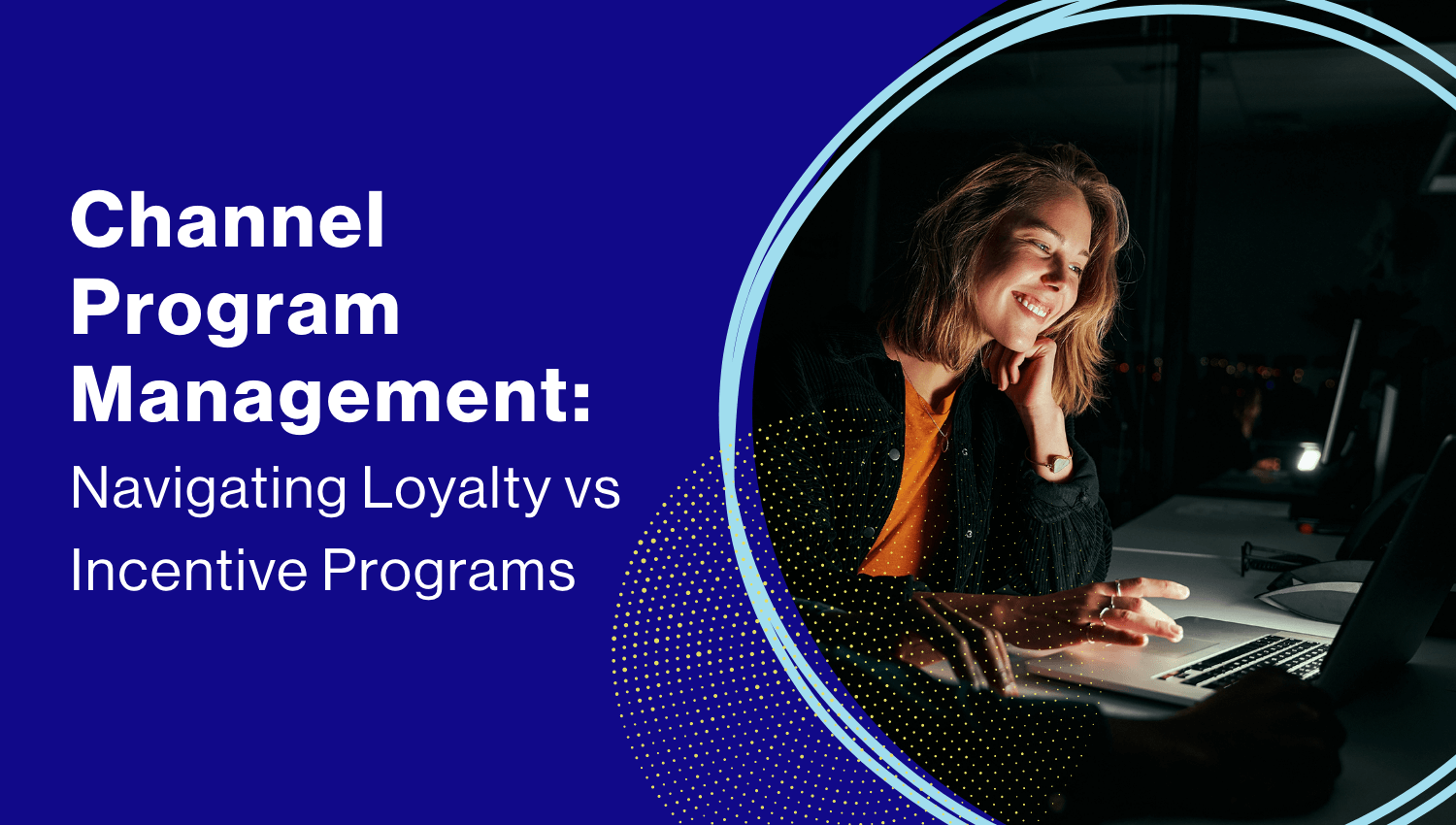
Many channel programs treat objectives like a pass/fail class: You and your partners either achieved the goal or you didn’t. Then, when goals aren’t met, program managers are left to determine why: Was it because incentives weren’t compelling enough? Did I miss opportunities to tailor the experience? Did engagement drivers not work?
Maybe, but it could also be that the goal is missing strategies that evolve it beyond just another good idea.
So how can you turn those ideas for growth into real and measurable program gains? Even before that, how do you as a program manager engage partners and get them to personally invest in channel objectives?
Step 1: Define the Goal & Your Flight Path
Where there are growth opportunities, there are goals to set. Defining goals is what gives them the strength to go the distance. It ensures clarity, guarantees measurability, and inspires confident action. Setting goals early in the design process is essential because it will drive important decisions later about rule structures and the partner experience.
Data reliability is also a must during this step. Progress needs to be measured as goals advance, meaning objectives always need to align with the data you’re tracking. For example, it wouldn’t make sense to set a goal to increase daily purchases if you’re only receiving data quarterly from distributors.
With definition and data in check, it’s time to start formulating a clear course of action that determines how you’ll measure success, and what steps correspond to each business goal that will be addressed.
If you get stuck, start thinking about some of your leading factors:
- What business goals will require participants to stretch their performance AND be considered fair and achievable?
- Should different levels of the participant hierarchy have different goals, and if so, what are the common elements that will keep everyone’s performance aligned?
- What performance metrics will accurately reflect the results the client wants?
Is there a baseline for current performance that can be used as a reference point for improvement? - How often should success metrics be measured and reported?
Answering these questions will get you started, but the work doesn’t stop here. Program participants need to be looped in to understand how goals will flow from ideation to execution, and the specific contributions they’ll make to get results.
Your goal achievement plan should be easy to retrieve and review within partners’ portals, or through relevant and routine reminders. If they’re fully up to speed, your sellers will have an obvious grasp on:
The “What” – The goal itself, what it is, and how it advances larger program objectives. Define whether it’s a short-term or long-term goal, its prioritization, what reaching it does for business and the role partners need to play.
The “How” – The step-by-step implementation plans outlining the objective, timelines, relevant checkpoints, potential obstacles and supportive resources needed. This can also include how you’ll measure performance and success.
The “When” – The ideal timeline for reaching the goal and major milestones. Go beyond simple start and end dates and identify a handful of checkpoints or milestones that signal progress. From here, you can determine the incentive opportunities and engagement drivers you’ll need to get partners moving.
The “What Else” – The additional resources required to reach your goal. Here’s where you can factor in market changes that may require additional training or product briefings to strengthen sales. It also includes program expenses, such as additional incentive options and partner costs, like new product inventory or extra showroom space.
As a program manager, you define and direct goals, and how you do this will impact the success of the individuals who can drive things forward.
Step 2: Align Values & Create Mutual Interest
The next step once goals are clear and communicated to partners is to focus on alignment. You’ll be looking for ways to bring your program participants closer to your brand and its values, and it helps if the values you elevate are advantageous to partners.
Obvious cornerstones of enablement and empowerment in your program make your partners want to invest in your success because you’re investing in theirs. When achieving your program goals translates into partners winning – that’s an opportunity they can easily get behind. Mutually beneficial experiences create mutual interest.
If partners are aligned with your program, it means you should be able to answer these questions with a confident “YES”:
- Have you clearly defined the vision and values that shape your brand and program – including your prioritization of partner success?
- Are partners aware of your short- and long-term goals and the role they play in achieving them?
Are your brand values evident in your partner interactions and program conditions? - What steps are you taking to advance your loyalty program or incentive program strategies?
- Do your partners understand how their efforts and progress are measured and rewarded?
- Do you empower partners with a sense of purpose and satisfaction when advancing or achieving program goals? Recognition? Rewards? Discounts? Other perks?
Step 3: Master & Measure Goal Progress with an Advanced Partner Platform
When partners are in sync with your business, growth is a given – but reaching goals means you and your partners need to know which are moving forward, and which need more attention.
You need a way to track progress, and a capable, easy-to-use, partner portal is a good place to start.
When you work with smart channel technology, you can take advantage of in-platform performance widgets that spark partner engagement and motivation. Plus, every login to track or check their status can act as another positive, loyalty-building touchpoint with your program.
Consider implementing in-platform features like:
Visual Progress Trackers
Shed motivating light on partners’ proximity to much-anticipated rewards, and flag upcoming opportunities to unlock certain status levels or tiers hinged on their contributions.
Partner Leader Boards
Gamify elements of your program and get sellers thinking about how their performance compares to others. Friendly competition drives increased engagement and performance and makes your program a lot more fun.
Step 4: Promote In-Platform Goal Sharing & Accountability
We’ve already established that goals need to be easily accessible in partners’ portals for them to stay top of mind, but you can also promote goal progress with collaborative opportunities.
Try establishing a partner forum to give your channel participants a place to share their goals, progress, challenges, and advice for other sellers.
By simply opening the door for in-program networking, your turf becomes a collaborative hot spot with additional opportunities for partners to gain support and beneficial insights from their peer community.
One thing to keep in mind is that additional asks, like getting partners to collaborate and share goals, will be an extra step for them. That means prompting action might require a gentle nudge – but that’s what incentives are for.
Step 5: Motivate Partners to Reach Goals with High-Value Incentives
Channel goals and incentives need each other to work. Without goals, there aren’t behaviors meaningful enough to motivate, and without incentives, there’s no muscle to move them forward.
Your move is to use the right incentives and prompt the right behaviors from the right partners. That means creating a lucrative and motivating program design.
Partner Segmentation
This is helpful when you want to group your partners into categories based on certain demographics to better target their interests and motivate them with meaningful rewards.
Incentive Rule Structures
To work, they need to be fair and lucrative and establish the actions that determine rewards. Incentive rules can also be flexible to reinforce other non-sales behaviors that advance goals. For example, a gallon of water at the marathon’s finish line vs. a paper cup at every mile—continuous value nurtures long-term motivation.
Incentive Types
Offering a variety of incentives and rewards is essential for appealing to the range of partner types you’ve already grouped during segmentation. It also does more for loyalty when there’s an extensive selection of meaningful items, experiences, and perks to choose from.
Step 6: Look at the Sum of Your Program Experiences
Incentivizing behaviors that put your goal within reach is important, but each of your program elements will need to work together. This step comes down to assessing the totality of your channel program and its features.
Are your experiences compelling? Are you creating the right conditions to get results? Is your program built to engage partners, motivate them to act, and help you surface the crown jewel of channel partnerships: loyalty?
A look inside your program toolkit can tell you how your goals will progress. Several components need to be active to get the best results every time:
- Data Analytics and Insights to bring clarity and direction to performance and progress.
- Tailored program designs to create lucrative and strategic incentive rule structures.
- A range of inventive types to fuel an equally diverse range of partner interests beyond monetary rewards (travel and experiences, new product discounts, merchandise and more).
- Dedicated channel experts will help define goals, strategize program designs, segment partner types, and understand key metrics.
- Hassle-free program tech to make logging in, reviewing goals and tracking progress simple.
- Enablement resources and support for sellers in the form of product knowledge and training, marketing materials, tech support, relevant communications, skill development opportunities and more.
The partner journey is an opportunity for your channel program. Everything from your program tech to your incentives adds to your brand and program image. You want to show partners that setting and crushing goals is the standard, and so is their potential to gain from every encounter.
Channel Management Tip:
If engagement needs a lift, or if it feels like something is missing from your program toolkit, diversifying your incentive portfolio and exploring these Channel Solutions is a great way to speed up results.
Now, Get Goal-ing!
Every channel program has the ambition to grow, but not every program will have a sound goal-setting strategy. Without it, it’s hard to know when to take which steps, and how to incentivize partner actions that make the greatest difference for your business.
When you combine a focused course of action with the right program tools, partners will not only engage with your objectives but also recognize that your program goals serve as their best opportunities to gain, grow, and advance in their careers.
Let’s create big goals! If setting program objectives has felt more like an obligation than an opportunity lately, we want to help change that. Our tailored channel solutions can empower you to tell a new story of channel partner success, and with our roots in data, program design, and behavioral science, we have the know-how to turn your most ambitious goals into revenue that speaks for itself.


